Howard Hunt
Production Test Driver and Press Fleet Manager – 1964 to 2007
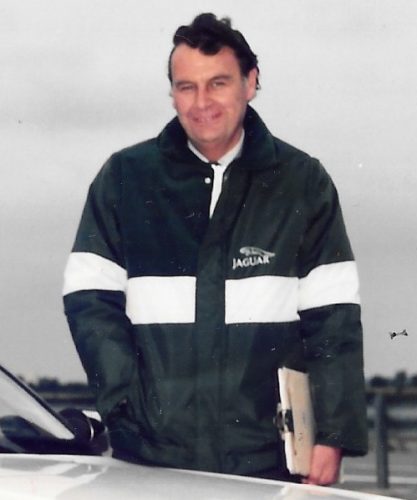
Howard Hunt Production Test Driver
Having provided some notes to Letitia Mace for an article she was working on for Exclusively Jaguar, Howard Hunt went on to document some of his experiences in the four decades he worked for Jaguar at Browns Lane.
The Road Test Years
I joined Jaguar Cars in the spring of 1964. I could not believe my luck, I had landed the job half of the British Motor Industry would have given their right arm for – a test driver with Jaguar Cars. All new Jaguars at that time were tested on the road at least twice, a large percentage of them three times, or even more. I was to work in the test and rectification department on first road test. Cars came to the department straight from the assembly tracks and had the final adjustments carried out to their automatic gear boxes and the windscreen wipers fitted, then made their first venture on to the open road in the hands of a first test driver.
Initially I spent two weeks with one of the very experienced Jaguar test drivers who showed me all the foibles and particular faults I would come across on the models in production at that time. I then tested three cars on my own – a Mark II, a Mark X and an E type which I had to present to the foreman test driver (a post I was to hold myself some years later). Thankfully the foreman was happy with my reports and I joined a group of extremely experienced and talented test drivers who had driven for virtually all the famous names in the British Motor Industry including one, the first to retire after I joined, who had driven for Sunbeam when it was still a free standing company.
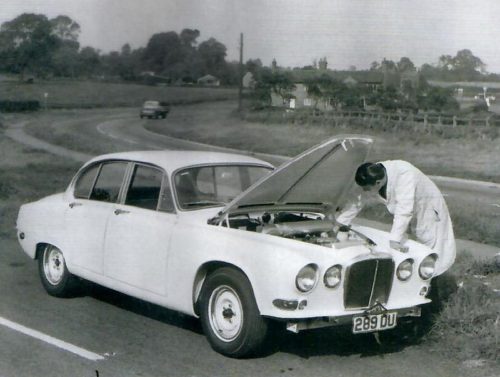
Testing a Jaguar 420 with his own trade plates 289 DU
The first morning clutching my trade plates (289 DU) I walked over to the cars awaiting first test – an exciting array of vehicles which included Mark IIs – 2.4, 3.4, and 3.8 – S Type – 3.4 and 3.8 – E Type – Mark X, including the little heard about Mark X limo – and the Daimler 250. This breath-taking line up was shortly to be joined by Daimler Majestic Major and the limousine with their magnificent 4.5 litre V8 engines when their final assembly was moved from Radford to Browns Lane.
My association with the Daimler limousines started here and continued right up to the final three built – two for her Majesty the Queen and one for the Queen Mother.
After the Ford takeover in 1989 Ford executives would often say to me “you are a two model company and always have been” and I used to quote the line-up of models that had faced me that first morning.
In later years I was often asked which car was my favourite model of that time. The expected answer was the E Type but the truth is I loved them all but my favourite as a club level saloon car dicer at the time was the John Coombes 3.8 Mark II which by that time came off the production lines with virtually all the competition goodies already fitted. Derrington wood rimmed steering wheel, Pirelli Cinturato tyres, gas flowed cylinder head, match manifolds, close ratio gear box, etc – only the louvered bonnet and flared rear wheel arches, if required, being fitted at John Coombes Guildford garage. Some historians still say all these goodies were fitted by Coombes but certainly by 1964 they were production line fitted.
Here on first test I had first contact with three facets that would be major features in my future career.
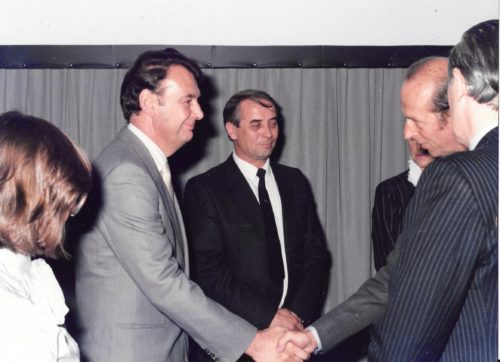
Howard Hunt being introduced to the Duke of Kent
- One was police cars, both Mark II and S Type appearing for test on a daily basis.
- Two was royal family cars. One car from that time that sticks in my mind in this category because it was fitted with a heated front screen normally only seen on rally cars at that time. The heating elements were thick and white and I found them quite distracting to drive behind.
The car was for the Duke of Kent and little did I know then that I would still be testing cars for him when I retired in 1999.
When the Duke made an official visit to Browns Lane in the late 80’s I was presented to him and I mentioned this first car of his, a Mark II that I had tested. HRH not only remembered the car reg but the body colour and the extras he had had fitted. - Three – Press Cars. My first contact with press cars was when I was assigned to run-in a Jaguar 420 and a Daimler Sovereign in 1966. At the time this was the entire press fleet for that model – how things were to ratchet up over the coming years.
Final Test
I was promoted in 1968 to Final Test. Here cars arrived after first road test having progressed down a rectification line manned by a mechanic, a body man and an electrician to have their first test report faults rectified. Cars with major faults like engine, gear boxes and axle changes were attended to in other areas before being fed down the rectification lines. Final test drivers were required to pass off 20 cars per day. Often less than 50% of the cars passed on their first run, some cars requiring two or even three tests. This resulted in final testers often driving up to 30 cars a day.
Sir William Lyons would occasionally appear near the end of the working day in the final test area, pick a car at random, and say “plate that up for me and I’ll take it home tonight”. This often meant there were two test drivers (final and first test drivers of the chosen car) who did not sleep too well that night.
With the exception of a couple of employees who had started with Swallow Sidecars at the outset in Blackpool in 1922, Sir William always just called everybody by surname. Norman Dewis once commented to Howard Hunt that he “must have gone up in Sir William’s eyes as he gone from being called “tester” to “Hunt”. Clearly he was on the way up!
During my time on final test, two interesting assignments came my way. The first, on Series 3 E Type introduction I was allocated my own rectification line and completed the road testing and final pass off for the first 25 Series 3s off the production line. The second was running in the XJ12 press car fleet. This job was given to the Road Test department and I was one of the team involved. Should you be in the car when it completed the required mileage the instruction was to do a speed test at a place of your own choosing on the way back to Browns Lane. No specific speed was ever mentioned. All I will say is that I acquired the highest speed in a Jaguar to date, to be exceeded years later in an XJ8 with a dicky speed limiter and finally trumped in a 220.
Promotion
I was appointed in 1972 to the position of test driver foreman on the retirement of our veteran test driver foreman Chris Hammond. Every major unit rejected by the test drivers – engine, gear boxes and axles, had to be verified by the foreman, problem cars that did not respond to the usual rectification methods would end up with the foreman to diagnose a solution to their problems. The position of foreman was an interesting and challenging job and it would be unusual if you had not driven 20 or more Jaguars at the end of the working day.
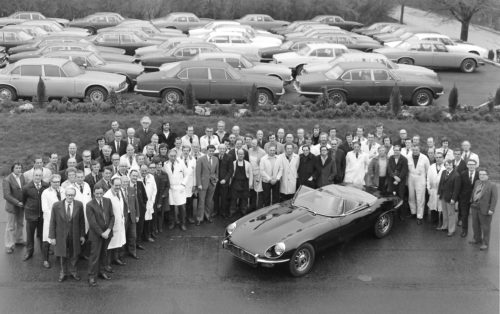
The last E Type HDU 555N
With Howard Hunt in the lineup
People tell me due to the positions I have held I have driven more E Types than anybody on the planet and they could well be right. Often in the 60s/70s the saloon car tracks would have to be closed down due to industrial strikes at component suppliers but the E track was able to carry on production. I remember on one of those occasions testing 110 E types in just two weeks.
I have already mentioned testing the first 25 Series 3 E Types and the way things worked out I drove the last 30 as well, with many more in between of course.
The final E Types were built on a temporary assembly track put in a newly constructed building that was to be the components stores. There was a last minute surge for the final E Types and more cars were built on this temporary track than were originally intended. The component suppliers had closed down their production lines and this resulted in cars being built very much not to spec. Wheel hubs were the main problem – cars arriving for road test with steel wheels on the rear and wires on the front or any other combination you could think of! We held the affected cars in Road Test and when one was required for sale two or three cars would be brought into the shop and the hubs swapped round to end up with four steel or four wire. In view of the disruption it was decided on high that I should give the once over to the final 30 cars even though the cars had been passed off by the final testers.
The Press Car Years
Digby Larque, the Press Car Department Engineer/Test Driver, was due to retire in 1978 and I was the successful applicant for his position. Digby was a real character who would race motor cycles on the Isle of Man and flew his own Tiger Moth. After his retirement Digby reverted to car delivery, the job he had started off in in the car industry after WWII. Digby was still delivering press cars to journalists for me in his late 70’s. Digby and I held this position in press cars between us for 39 years. Although appointed to my position in press cars in November 1978 I did not take up the post until spring 1979. The XJ Series 3 introduction was imminent, the press fleet preparation was well under way in press cars for the launch in March at Torquay’s Imperial Hotel, and in test and rectification I was part of the team introducing Series 3 into production – an operation still very much in progress. In view of the situation it was decided that Digby would delay his retirement for six months and I would remain in test and rectification until after Series 3 launch.
I finally joined press cars in April 1979 and from then on was involved in every press launch right up to XF. My boss in my new department was Peter Taylor, an ex-Jaguar apprentice. I had first met Peter in 1964 when he passed through test and rectification while serving his apprenticeship. On completing his apprenticeship Peter joined Norman Dewis in vehicle proving. Peter was involved in the testing and development of Series 3 E Type, XJS, XJ6, XJ12 and many others. In 1974 Peter raced a V12 E Type FHC winning the British Prods Sports championship. Peter moved to Press Cars in 1975 where I joined him in 1979 and he remained my boss until after XJ40 launch when he moved back to engineering in 1987. Peter’s path and mine were to cross many times in the coming years in various roles, including a period after we had both moved on from Jaguar when Peter once again was my boss.
Press Car Department Function
The principal function of the department when I joined was the preparation of the Jaguar press car fleet for loan to the motoring press for their assessment. These loans could vary from driving impressions of individual journalists to full technical tests by the motoring magazines. The odd car was also loaned to VIPs and to motoring magazines for long term assessments. Additions to this primary function included preparing cars for use by the Royal family and checking out VIP customer cars before despatch from the factory.
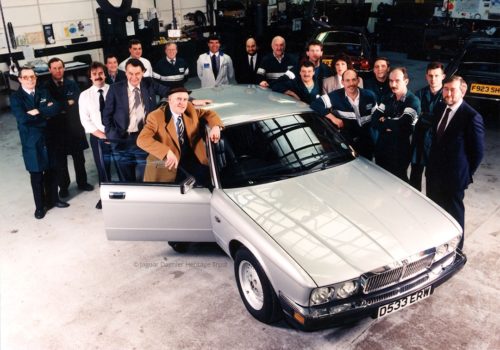
Howard Hunt standing behind George Cole with Jaguar XJ40
The department also provided cars for use by TV companies for what is generally termed as ‘product placement’. Among these was the long running Minder series produced by ITV featuring George Cole as ‘Arfur Daly’ and all of the three or four cars used in the series were press cars. [Howard Hunt was surprised, on a visit to the Collection Centre at Gaydon, to see himself on one of the walls, standing behind George Cole in one of the publicity photographs.]
In the John Egan years the department commitments expanded enormously and included running a fleet of police car demonstrators, fleet sales demonstrators, promotions cars which were used to support various events round the country, HSVs (high security vehicles) which in a changing world were becoming very important, and embassy cars for British embassies around the world plus foreign embassies in London. At one time most of the non-car producing countries embassies in London ran a Jaguar. All this influx of work resulted in the department’s name being changed to Special Vehicle Preparation, but right up till my retirement in 1999 everyone at Browns Lane still referred to us as Press Cars.
Some Jaguar historians have written that the labour force in Press Cars came from Engineering (Experimental) but like me 95% of the personnel came from test and rectification (Production Road Test).
Jaguar press launches of new models were few and far between in my early years serving in press cars and it was May 1981 before I was involved in a major international press launch of a new model. The car was the XJS HE fitted with the May fireball cylinder heads and enhanced trim which included elm burr veneer for the fascia and door cappings and chrome bumper cappings. I know this may upset some of my Jaguar colleagues but this car, in my opinion, was when the XJS became a real Jaguar. After running in and preparing the cars at Browns Lane the international press launch took place at Woodstock in Oxfordshire, home of Blenheim Palace. I know until recently one of the launch fleet cars survived – RDU 921W – in the hands of Graham Mitchell. The last time I saw a photograph the car still looked immaculate. Is that car still with Graham? The period it took to introduce new models was to reduce dramatically during my time in press cars due to the advances in technology, a large increase in the engineering headcount, and gaining access to Ford systems after the takeover.
Much has been written about XJ40 launch and it was certainly one of the most important press launches in Jaguar’s history. XJ40 finally made it to production after a long gestation thanks to the tireless efforts of Jim Randle, director of product engineering, and Chairman John Egan’s inspiring and forceful leadership. Everyone at Jaguar was incredibly busy in the run up to and the period following the XJ40 launch.
XJ40 Launch For Me Personally
Lots of midnight oil was burned in the preparation of the press launch fleet of cars at Browns Lane. Modifications and updates came in daily, sometimes 10 or more in a single day, all of which had to be incorporated on to the launch fleet, and all in addition to the normal preparation.
I was despatched by my boss Peter Taylor to Dunkeld in Perthshire, Scotland, three days before the rest of the team, to finalise the setting up of our workshop in a marquee erected alongside the hotel being used for the launch – Dunkeld House Hotel – and to receive the cars when they arrived on their transporters. The transporters could not negotiate the hotel’s arched gateway entrance so I had to unload the cars in the village and quickly spirit them away down the drive and get them out of sight in the workshop. Bearing in mind that no photos of the XJ40 without its disguise kit fitted had sneaked out up to this point it’s a wonder nobody got that first photo on their journey to Scotland on the open transporters of the day. Incidentally this was the last Jaguar press launch where the cars arrived on unenclosed transporters.
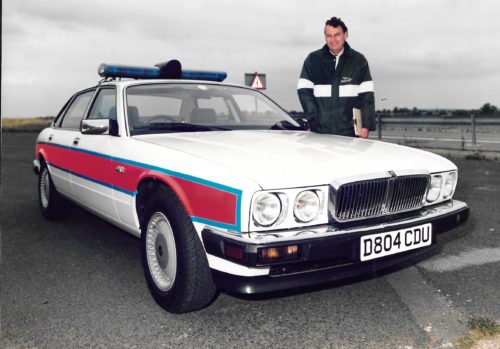
Howard Hunt with a police demonstrator at the Gaydon XJ40 launch event
After three weeks at Dunkeld working with Peter and our team the launch was up and running very successfully. At this point I returned to Browns Lane to prepare a fleet of cars for what, due to the security situation at the time, is a little known of event, the XJ40 police car, HSV (armoured cars) and embassy cars launch which was to take place at the Gaydon proving ground over three days. Each day a third of the British Chief Constables, or their deputies, were present, plus high flyers from various Government agencies including some with department numbers beginning with M …. There were also representatives from many of the London foreign embassies. With all the assembled guests gathering in one room for lunch you can see why there was a security element involved in the operation.
There were eight cars available for the guests to drive on the test track, plus two HSVs which I was to demonstrate to selected passengers on the circuit. The cars available on the event were four XJ40 police demonstrators, (two of which still survive) the XJS police demonstrator which is still with Heritage, a Daimler Double 6, an XJS V12 and an XJ40 2.9 manual. Driving the armoured cars was a headache for me, literally, as the early armoured cars suffered distortion in the front windscreen bullet proof glass and driving them all day resulted in said headache. The V12 armoured car was no slouch on the performance side with the lowered axle ratio acceleration figures only slightly down on a standard car and top speed was virtually unchanged. Coming off the banking and flat out down the straight I usually had 135 mph on the clock when approaching the hairpin. I never mentioned to my passengers that when forced off line by other traffic I sometimes had a somewhat blurred view of the hairpin apex through the distorted screen.
The Gaydon event was a great success resulting in a considerable number of orders for these specialised vehicles. I had three busy days after the Gaydon event preparing the police demo cars after their pounding by heavy footed policemen round the track for loan to our local police forces, while at the same time reworking the two armoured cars for what was to be my next activity in the XJ40 launch programme.
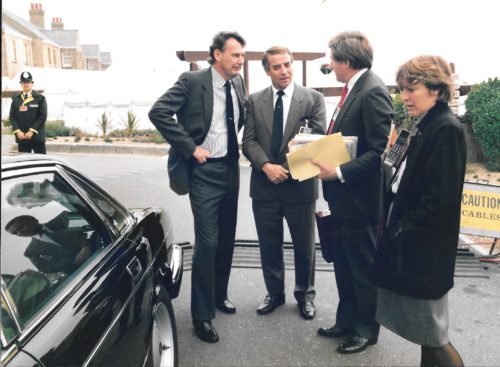
1986 Howard Hunt at the Conservative party conference.
With George Hind and Jonathan Dimbleby discussing the PM’s new HSV watched over by the long arm of the law
The Conservative Party Conference in Bournemouth coincided with the public launch of the XJ40. This was the year after the Brighton bombing and security was at maximum level. I was there to keep an eye on the Prime Minister’s HSV (high security vehicle) which had only recently been delivered from Browns Lane and I had with me an XJ40 Sovereign auto for Ministers and MPs to inspect and drive, plus the two HSVs from the Gaydon event as back up for the PM’s car and for use by Ministers as decided by the security forces.
I was based, with my vehicles, in the conference halls underground garage reserved for use by the police and security forces, very interesting and informative.
I represented Jaguar while at the conference at the local agent’s official public launch of the XJ40 and watched an XJ40 appear from behind curtains with a blast of music, lasers, and multiple flashing lights – for the second time – having seen a rehearsal of the agent’s presentation at Browns Lane.
After an eventful four days at the conference I returned to Browns Lane. All of this was my personal involvement in the introduction of the XJ40 to the world. Phew, 35 days, 7/7 – I certainly enjoyed my first day off at the end of it!
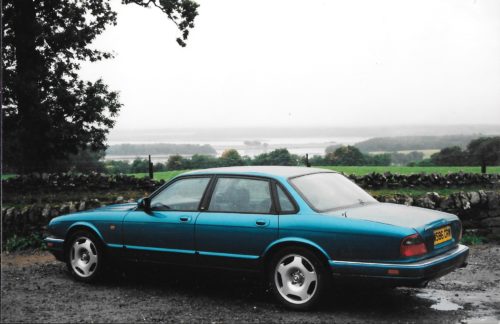
X300 at the Skibo launch
One new Jaguar press launch cannot pass without a mention is the X300 – the ultimate XJ40, and one of my favourite cars. With the benefit of many more engineers and some of the Ford system starting to kick in there was a great improvement in quality and reliability. The car drove and handled well and really looked like a Jaguar with its front and rear end styling changes. I’m sure Sir William looked down and thoroughly approved.
The X300 launch took place at Skibo Castle in the Scottish highlands. My workshop was in an old cattle barn on the estate from which we enjoyed magnificent views across the incredible Scottish countryside. Another bonus was the moment I drove on to the road outside the workshop I was on perfect roads for the testing of cars, magnificent scenery thrown in for free. There were more engine options available on this launch – AJ16 3.2 and 4.0, AJ16 supercharged, and the V12 in the Double 6 – than had ever been seen on a new Jaguar car press launch.
Notable Others
The first new Jaguar to come to the production lines, on time, on budget, and almost on weight (Jaguars always seem to gain weight in production) was the XK8. All of this was achieved under the capable hands of Project Director Bob Dover. After I had received and tested the first half dozen cars of the press fleet Bob called in to my office to get my impressions. I told Bob I was impressed but backing out of our car park on rainy days visibility through the rear screen was not brilliant, a wash/wipe system would be nice. Bob replied “what would you like to take off the car to the value of wash/wipe?” I could not think of anything I wanted to lose – that’s how you keep a car on cost. Two days later Bob came to my office and gave me a box of ScreenX. The weather at Chateau Chailly, the launch site just north of Dijon, was perfect during the launch so I never had to use them. There’s still a bottle sitting on my garage shelf 24 years later.
The final new car launch for me as a full time Jaguar employee was the new S Type saloon. This launch took place in Biarritz in the south west of France early spring 1999. This was not a launch without its problems, not least the weather – it rained every day but two, in the six weeks we were there. I had produced a driving route that ran high into the Pyrenees with magnificent views of snow-capped mountains. Unfortunately due to the weather there were only two days when visibility was good enough for the view to be enjoyed by the visiting journalists. At least the inclement weather enabled us to discover that in spite of a comprehensive water test on the new Castle Bromwich assembly line our cars were leaking like sieves! The major problem at the launch was Pirelli had run into production problems with the tyres resulting in the tyres we had prepared the cars on, being suspect and necessitating a last minute change to Continentals. This produced all sorts of problems, not least of which was a deterioration in ride quality. Eventually, after much burning of midnight oil in the workshop, all problems were overcome and the reports from the attending journalists were very positive.
The Route Man
Somewhere along the way I became known to the visiting journalists from around the world as “The Route Man”. David Boule, our Public Affairs Director, had brought in an outside company to produce a driving route for a forthcoming launch. When that route arrived on his desk he called me into his office and said “Can you drive this route in one of the launch cars and tell me what you think?” Basically my report back said “This route does not showcase our car well and there are far more interesting and scenic roads to drive in the area.”
I was despatched the next day to compile a route of my own. David drove the route and loved it. From then on I became “the route man” for all Jaguar driving routes at launches around the world and for parties of journalists visiting Browns Lane.
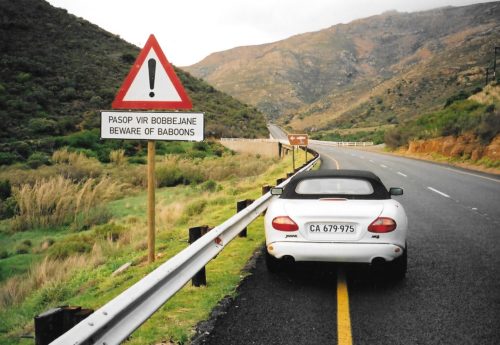
Unusual road hazard in South Africa
I am a lover of the countryside, history and, of course, a very keen driver. All of these things aided me in putting together interesting driving routes. My policy was always to have a challenging road route that showcased the particular car being launched to its best. Although common now I introduced many years ago adding notes to the tulip routes on places of interest, places of historical significance, and notes on the countryside you were passing en route. Often visiting journalists would send the senior journalist to seek me out and tell me on their behalf how much they had enjoyed the driving route.
On one occasion the head journalist of a visiting Italian group (an ex racing driver) came up to me and said the route was “Magnifico, I knew this was put together by a driver after the first few kilometres.” He then hugged me and gave me a kiss on both cheeks, resulting in me receiving for the next few days a ribbing from the rest of the team – you can imagine! I only hoped he was not a member of a well known Italian secret society …..
I only modified the original XJ40 launch route (1986) for the XJ40 4.0 launch three years later (1989) but every Jaguar road route journalists from around the world drove after that was my handiwork – XJ40 4.0 1989 to XF 2006.
Perks Of The Job
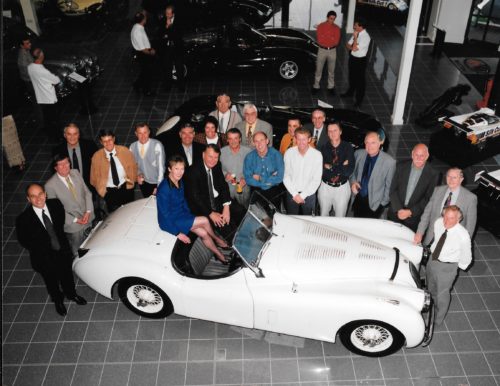
17 September 1999 Howard Hunt with NUB 120
at his retirement party
In my position as Project Engineer Press Cars not only did I get to drive all Jaguar’s production models but for comparison our competitors models as well. At journalist driving days and new car launches we always had a selection of cars from Heritage for me to drive with selected journalists as passengers which resulted over the years in me driving everything from the Austin Swallow onwards. Sadly the exception was the D Type – I have driven D types but only inside Browns Lane or driving to the display position at a launch – so I don’t count that.
The car I drove most from the Jaguar Daimler Heritage Trust collection was the famous Alpine Cup winning XK120 NUB 120. I tested and serviced NUB several times over the years and demonstrated the car to journalists. I also demonstrated NUB to Ford El Supremo Jac Nasser’s wife (that’s a story on its own) appropriately the car was at my retirement party and the party photos were taken with me and my wife sitting in NUB.
During journalist’s test drive days I got to drive Jaguars on just about every race circuit in the UK, plus a few on the continent. I also drove on most of the industry test tracks including at MIRA, Millbrook, and Gaydon. I got paid as well!
The Afterlife
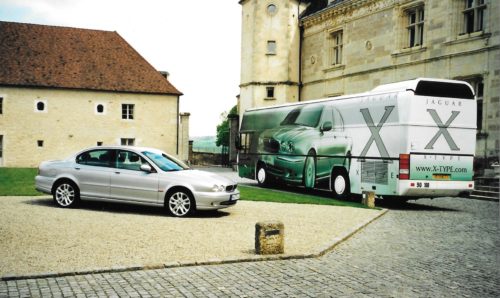
The X Type battle bus for transporting journalists
I had always planned to retire early and with my plans falling into place I applied to leave Jaguar at the end of September 1999. In spite of some amazing and very tempting offers to stay on I stuck to my guns and duly retired as planned.
I was invited to attend a meeting at Browns Lane in the spring of 2000 where I was offered an extensive part in the forthcoming launch of the four wheel drive X Type. Accepting the offer, I started my seven years of “part time” service with Jaguar.
My first task in the X Type launch preparation was to visit possible sites, chosen by PR, for the world press launch. These sites were spread all across Europe. I visited each one to assess the roads in the area for their suitability for an X Type test drive route for the launch, and investigated at each site where we could establish an on-site workshop. Although not my field I was also charged with giving my opinion on the selected hotel at each possible venue. All this resulted in a somewhat lengthy report.
When the launch venue was finally chosen I revisited it to compile the road routes that the journalists would drive in their assessment of the car and to complete the final plans for the on-site workshop. When the route was finalised I was supplied with a BMW 3 Series to push round the route and to give my opinions on how it would compare in future back to back tests with the X Type. By now the X type was an in the metal reality at the Halewood assembly plant in Liverpool. I visited Halewood to view the car being built and give advice to the workshop established at Halewood to prepare the press fleet, road testing some of the early cars during my visit.
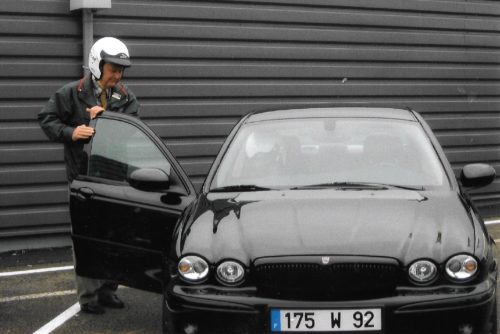
Howard Hunt about to demonstrate the X type capabilities on the Circuit Maison de Auxois Sud
A case of déjà vu was next in my X Type involvement. Peter Taylor, my old boss, had left Jaguar in the early 1990’s along with a lot of Jaguar engineers. Peter had formed his own company doing vehicle development and validation and had the contract to run-in and test the X Type press car fleet. I joined Peter and we developed a base, lent to us by Jaguar, at the Gaydon proving ground. We hired a team of former industry test drivers to complete our team. We received the cars from Halewood, ran them in on the road for their initial mileage, then on the test track for a period of high speed running. On reaching the required mileage I tested each car, wrote a rectification report, and returned the cars to Halewood by transporter.
Finally in the X Type saga I returned to full time employment for two months to do my old job at the international press launch site at Chateau Chailly just north of Dijon.
Highlights for me that come to mind from this period include demonstrating the car’s handling to journalists on the circuit Maison de Auxois Sud, a small racing circuit near the launch site, driving Jaguar Heritage’s C type on typical French tree lined roads, and at the end of the launch taking a party of Australian journalists on an extended three day drive. First down to Monaco using some of the high cols in the Alps, then two more days of alpine driving on the Route Napoleon, and various other high-altitude roads. A great way to finish off X Type press launch.
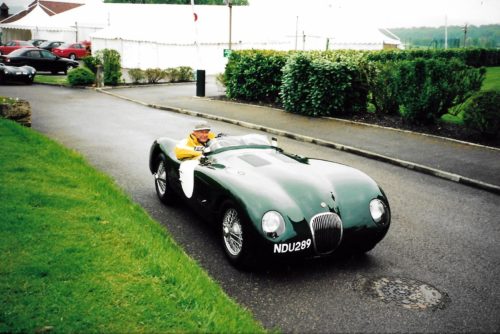
Howard Hunt driving the C Type NDU 289 at X Type launch
Back at Browns Lane during the post launch wash-up meeting I was asked if I would continue in the same vein for future new Jaguar car launches. This was a little too near full time for me and what we eventually agreed was that I would do the driving routes for future launches and attend the launch on occasional days to drive with selected journalists, and organise and accompany any long distance European drives as per the Australian drive after X Type. In addition, I would compile driving routes in the UK for foreign journalists visiting Browns Lane and accompany them on their drive.
Finally in 2007 I decided the time had come to fully retire. 1964 to 2007 = 43 years, or Mark II to XF. There were many memorable and interesting occasions in those four decades some of which I hope to recall in future writing.
Footnote
I thought when I initially retired in 1999 ‘S type to S type’ would have been a very appropriate title for my Jaguar career and it also had a nice ring to it, but the afterlife blew that possibility!
Author: Howard Hunt
Editor: Tony Merrygold
© Text and Images – Howard Hunt